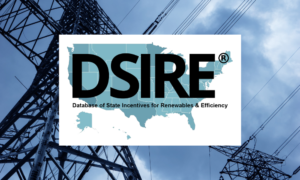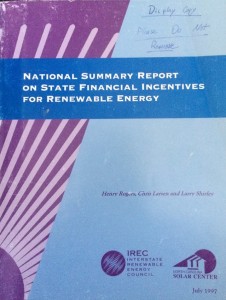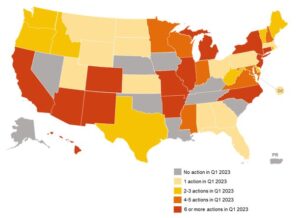35 Years of NCCETC: A Deep Dive Into the Database of State Incentives for Renewables and Energy Efficiency (DSIRE) & DSIRE Insight
The North Carolina Clean Energy Technology Center (NCCETC) at NC State University is celebrating its 35th Anniversary in 2023. Originally founded in December 1987 as the North Carolina Solar Center, NCCETC is a public service center with a mission to advance a sustainable energy economy by educating, demonstrating and providing support for clean energy technologies, practices and policies.
 In 1995, NCCETC was awarded a contract from the U.S. Department of Energy (DOE) to build a Database of State Incentives for Renewable Energy. Today, the database has grown into the Database of State Incentives for Renewables and Efficiency (DSIRE) and is recognized as the most comprehensive source of information on clean energy related policies and incentives in the United States.
In 1995, NCCETC was awarded a contract from the U.S. Department of Energy (DOE) to build a Database of State Incentives for Renewable Energy. Today, the database has grown into the Database of State Incentives for Renewables and Efficiency (DSIRE) and is recognized as the most comprehensive source of information on clean energy related policies and incentives in the United States.
A Brief Background – From DSIRE on Disk to DSIRE Online
Larry Shirley, the founding Executive Director of NCCETC, regards the creation of DSIRE as one of the most notable achievements from his time at the Center. During his time working with state agencies, utilities and regulators across the United States, Shirley identified a need for a central database of policies for policymakers to reference.
Given our federalist system of government, the power to regulate the electric utility industry and shape the marketplace for renewable energy is shared between the federal government, all 50 state governments, and local governments. Policy has a huge impact on the market for clean energy technologies, and the different approaches chosen by different states can result in very different outcomes for the development of renewable energy and energy efficiency. Smart policies can accelerate the transition to clean energy and all its benefits, while a lack of policy development can slow or stifle the transition to clean energy.
At the same time, the policy landscape is constantly changing and can be difficult to understand without spending hours pouring through legislation and regulatory dockets. Even policymakers, while familiar with their own state’s laws and regulations, often look to other states when considering policy changes. DSIRE, which is publicly available, helps homeowners and businesses, the clean energy industry, utilities, policymakers and others understand the nation’s policy landscape.
In a recent interview, Shirley described how he took the idea for DSIRE to the Interstate Renewable Energy Council (IREC) in the early 90s with a goal to create a national database of all state and utility programs, incentives and regulations that promote the use of renewable energy. He said, “I envisioned a central database that could be a tool for everyone.” The partnership with IREC was instrumental in acquiring the grants from the U.S. DOE which originally funded DSIRE, according to Shirley.
 Before DSIRE went online it was available for purchase in hard copy and floppy disk formats. The National Summary Report on State Financial Incentives for Renewable Energy and The National Summary Report of State Programs & Regulatory Policies for Renewable Energy were sold separately for $25 for state and federal agencies and nonprofit organizations, and $50 for everyone else. For $25 anyone could receive the DSIRE on Disk Database Application.
Before DSIRE went online it was available for purchase in hard copy and floppy disk formats. The National Summary Report on State Financial Incentives for Renewable Energy and The National Summary Report of State Programs & Regulatory Policies for Renewable Energy were sold separately for $25 for state and federal agencies and nonprofit organizations, and $50 for everyone else. For $25 anyone could receive the DSIRE on Disk Database Application.
Along with DSIRE being different in the late-1990s, the policy and incentive landscape was also quite different with just 118 state-administered financial incentives across the country in 1997. Since 1998, DSIRE has grown from offering 400 state and utility incentive programs focused on renewable energy to now including summaries of more than 2,600 incentives and policies related to renewable energy, energy efficiency, energy storage, electric vehicles, and more.
DSIRE first went “on Line” in 2000, allowing users anywhere to access summary tables and individual policy summaries. The DSIRE website now features interactive maps and search features, attracting approximately one million unique visitors each year.
Visitors to dsireusa.org can also easily move from education and research to taking the next steps in going solar through a collaboration with EnergySage, an online comparison shopping marketplace for solar. Since 2017, Energysage and its full set of tools have been made available through DSIRE, including comprehensive solar data on pricing and savings. The EnergySage Solar Calculator is a free tool which allows users to quickly estimate their solar potential and savings by address. Estimates are based on the user’s actual roof and electricity bill, plus real-time price data from offers in their area.
Brian Lips manages DSIRE and is a Senior Policy Project Coordinator for NCCETC. “We’re constantly working to expand the database and ensure programs are kept up to date to maintain DSIRE’s status as the one-stop-shop for reliable information about policies and incentives for clean energy technologies.”
NCCETC announced the addition of incentive programs for electric vehicles and charging infrastructure to DSIRE in 2021. DSIRE now includes over 250 incentive programs for the purchase of electric vehicles and associated charging infrastructure.
Diving Deeper with DSIRE Insight & The 50 States Reports
The staff behind NCCETC’s Policy & Markets program conduct objective research and analysis and can provide educational and technical assistance on energy policy issues nationwide. In addition to operating DSIRE, the Policy Team provides policy research and analysis services to energy professionals via DSIRE Insight.
DSIRE Insight launched in December 2018, expanding upon DSIRE and the 50 States quarterly policy tracking reports. DSIRE Insight’s subscription services focus on distributed solar, grid modernization and energy storage, and electric vehicles, as well as customized energy policy research. Example services for customer policy research and analysis include comparative state policy analysis, evaluation of market opportunities based on policy environment, and legislative/regulatory tracking on topics not included in standard subscription packages.
Currently, NCCETC’s team of analysts publish two biannual data sets. The State PURPA Policy Data publication details legislative and regulatory actions related to Public Utility Regulatory Policies Act (PURPA) across the country including a review of current PURPA implementation by state, including links to relevant statutes and regulations. The Investor-Owned Utility Avoided Cost Data details avoided cost rates for each U.S. investor-owned utility.
The 50 States report series is intended to keep industry stakeholders informed of policy and regulatory changes in the clean energy sector with timely, comprehensive and unbiased updates. As part of the series, NCCETC publishes three quarterly reports that provide a comprehensive review of policy changes under consideration related to three technology areas: (1) The 50 States of Solar, (2) The 50 States of Grid Modernization and (3) The 50 States of Electric Vehicles. Reports provide a complete review of quarterly actions, summarized by a team of state policy experts, along with links to primary sources, summary graphics and analysis.
Complimentary copies of 50 States reports are available upon request to state and federal lawmakers, state utility commissioners, state utility commission staff, state consumer advocate office staff, and state energy office staff. In the year 2022, NCCETC provided complimentary copies to policymakers or regulators in more than ten states, plus the U.S. Environmental Protection Agency and Federal Energy Regulatory Commission. These states include California, Colorado, Georgia, Hawaii, Mississippi, Montana, North Carolina, New Jersey, Oregon, Pennsylvania, Rhode Island, South Carolina, and Virginia.
Earlier in April, NCCETC released its Q1 2023 edition of The 50 States of Solar. The report finds that 41 states, plus the District of Columbia, took some type of distributed solar policy action during Q1 2023 (see figure below). The report identifies three trends in solar policy activity taken in Q1 2023: (1) basing net metering successor compensation on time-varying and/or avoided cost rates, (2) addressing community solar project siting in program design, and (3) increasing low- to moderate-income customer participation requirements for community solar programs.
Q1 2023 Policy Action on Net Metering, Rate Design, and Solar Ownership

Keeping Up with the Ever-Evolving Energy Policy Landscape
NCCETC continues to update its publications and services to reflect the changes happening in the clean energy industry. The team behind the 50 States report series is now excited to launch its first edition of The 50 States of Power Decarbonization in May 2023.
This quarterly series will have insights on state regulatory and legislative discussions and actions related to carbon reduction and clean power. The Power Decarbonization report is the first series added to the 50 States reports since The 50 States of Electric Vehicles was launched in 2018.
“We’re very excited to be launching The 50 States of Power Decarbonization next month, which will track proposed changes to holistic state clean energy policies, such as renewable and clean energy standards, emission reduction targets, and carbon pricing,” shared Autumn Proudlove, lead author of the report and Associate Director of Policy & Markets at NCCETC. “The report will also examine utility integrated resource plans, tracking planned capacity additions and retirements, in order to look at the connection between state policies and utility planning.”
THE INFLATION REDUCTION ACT OF 2022
The Inflation Reduction Act (IRA) of 2022 is a major piece of legislation, representing the largest ever investment in renewable energy, energy efficiency and electric vehicles by the federal government. The bill extended and modified a number of existing tax incentives with new requirements and bonuses to favor or require onshore manufacturing, development within disadvantaged communities, the use of fair labor practices, and other policy priorities.
“There are many key provisions included in the IRA, and DSIRE is being updated to incorporate all those that fit within its scope,” Lips noted. DSIRE staff have already updated hundreds of programs in the database this year, including all the tax incentives modified or established by the IRA.
Lips previously discussed provisions in the IRA that targeted the residential sector in a blog post, “The Many Incentives for Homeowners in the Inflation Reduction Act”, on DSIRE Insight. The article gives an overview of five tax credits that can benefit a homeowner or prospective car owners which are available now and future incentives which are in development as a result of the IRA.
The IRA also provides multiple incentives related to heat pumps. Heat pumps are a clean, affordable and efficient substitute for traditional fossil fuel furnaces and other heating/cooling systems. “The Good Kind of Global Heating (And Cooling)” article delves into the incentives stipulated in the IRA as well as state incentives currently available to support clean technologies like heat pumps.
Nuclear power is another clean energy source which was given a signal of support via the IRA. The legislation provided current nuclear power plants with a plethora of financial incentives to take advantage of. More information about the numerous financial incentives offered by the federal government and some states can be found in “Nuclear’s Next Life.”
Understanding the policy landscape is critical for clean energy businesses to identify market opportunities and limitations and to connect individuals with the tools to advance the use of renewable energy and overcome barriers to adopting clean energy technologies. NCCETC plans to continue expanding DSIRE as well as other services offered by its policy team to keep industry stakeholders informed of new policies and policy changes under consideration across the country.
This article is part of a series highlighting the work done by the NC Clean Energy Technology Center throughout its history in celebration of its 35th Anniversary. View the previous article to get a retrospective with the first Executive Director of the Center.